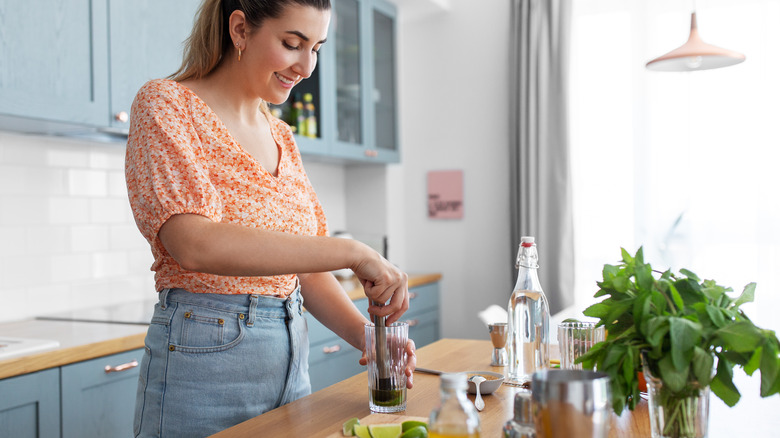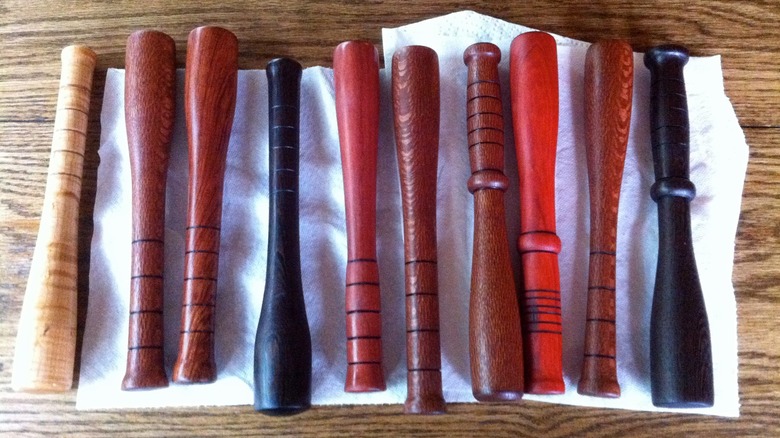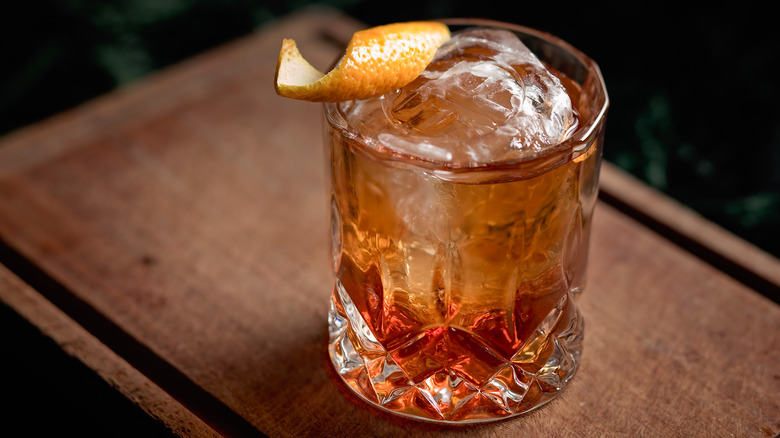The Ruinous Mistake You're Making When Muddling Cocktails
The act of muddling, or mashing ingredients to extract their flavors and aromas, is an essential step in making many iconic cocktails. The mint julep, for example, would be unrecognizable without muddling, and the same goes for classic sippers like the old-fashioned, mojito, Sazerac, and caipirinha.
Although the muddler is a very primitive bartending tool — it's a variation of the even more primitive pestle, and in most cases, is little more than a stout wooden stick — its use actually requires a bit of sophistication, in the sense that not all cocktails should be muddled in the same fashion. Although this crucial distinction is old hat to most professional mixologists, it's not as well understood by home bartenders, and as a consequence, many a cocktail has been ruined.
This distinction is between cocktails that require the muddling of fruit, and those that require the muddling of herbs. The latter must be treated much more gently, as plants rebel against overly rough treatment. In fact, they literally rebel, emitting bitter chemical flavors as a matter of self-defense when heavily bruised. What's the best way to avoid this ruinous outcome? Well, there's a reason most muddlers have two differently-shaped ends.
Different muddlers, different techniques, different results
Not all muddled classic cocktails are muddled equally, in other words. The tool itself is built to handle different techniques — and ingredients. At least, that's the case with traditional muddlers, which have one end rounded like the top of a baseball bat, and one end which is smaller, with a flat, circular base. These differing ends exist for a reason. The rounded bat-like end is perfect for pulverizing fruit, for example, while the smaller flat end is more appropriate for handling delicate, fragrant herbs like mint, which is an ingredient in several iconic cocktails.
This smaller end should be used to give three or four lightly pressed twists to herbs while they're being muddled with sugar in a mixing glass, as it is for a mojito or mint julep, for instance. You'll know if you did it right, as an amazing aroma will waft up from the mixing glass. It should also be evident if you've over-muddled and bruised the plant, as the result will be bitter chlorophyll instead of subtle, fragrant sweetness.
What do you do if you have a different style of muddler, one that's more uniform in shape like a rolling pin? It's not ideal, nor is a variation of the traditional muddler with teeth on the bottom, as it tears the leaves. In the latter instance, a wooden spoon is preferable. With the former, be as gentle as possible.
Mastering the muddler for iconic cocktails
Now that you know the secret to making great mojitos and mint juleps, you may as well brush up on your technique for other iconic muddled cocktails, too — the caipirinha, for example, a Brazilian favorite that pairs rum-like cachaça with muddled sugar and fresh lime. Sugar is a key ingredient in virtually all muddled cocktails, and not only does muddling dissolve sugar properly, but it also blends its sweet flavors wonderfully with lime's extracted oils and juices. No need to be overly gentle when muddling this classic. Use the larger, rounded edge of the muddler and firmly press and twist four or five times.
Neither fruit nor mint is muddled in a classic Sazerac. This New Orleans-born sipper is one of the oldest of all American cocktails, dating back to the 1830s. To properly muddle it, sugar and water are required, along with two kinds of bitters (Peychaud's and Angostura). Dissolving the sugar cube is the most important aspect, and it's easily accomplished by using the flat end of the muddler. Afterward, add the appropriate liquors with ice, and garnish.
The old-fashioned is similarly prepared, as only a sugar cube, water, and Angostura bitters are muddled. In fact, if the sugar isn't in cube form, don't even bother muddling. Just stir before adding whiskey, rocks, and a garnish of cherry and orange peel. No, the cherry should not be muddled.



